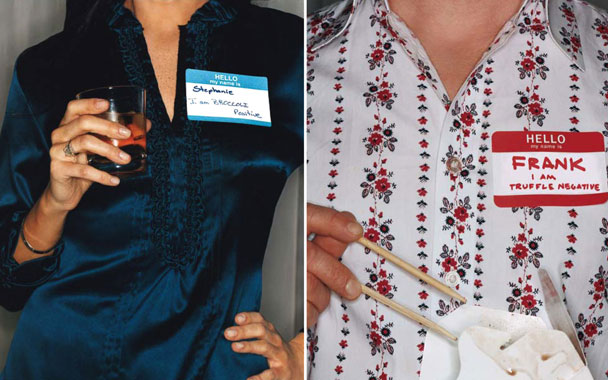Some revolutions are waged in blood. Others, in tomato juice. In a nameless conference room, in a faceless industrial park, off a lifeless exit on the New Jersey Turnpike, I am staring at four Dixie cups. One contains V8 juice (an eight-ounce serving of which has 480 milligrams of sodium, or 21 percent of the recommended daily allowance), one contains low-sodium V8 (in which almost a doubling of potassium chloride has cut the amount of sodium by more than two thirds), and the others contain low-sodium V8 mixed with different amounts of a concoction called Betra, which is designed to block the unpleasant aftertaste of potassium chloride.
This stretch of New Jersey is referred to as the Flavor Corridor, because many of the leading manufacturers in the multi-billion-dollar-a-year global flavor and fragrance industry have offices here, including Swiss giant Givaudan ($3.9 billion in sales last year) and America’s leader, IFF ($2.3 billion). Betra, though, is produced by Redpoint Bio, one of a few small companies that are threatening to overturn the artificially flavored apple cart.
The reason for this sudden shake-up: Staggering breakthroughs in scientific research, many accelerated by the decoding of the human genome in 2003, have completely rewritten our understanding of taste. “Flavor chemistry is finished,” says Cornell University’s Terry Acree, a leading flavor chemist with more than 40 years of experience. “Flavor chemistry is finding the chemical molecules that are important to aroma and taste. We spent decades doing this. But the other side of the equation is what’s been missing: how these chemicals interact with our bodies. That’s the part we’re getting to now.”
And what they’ve found is that nearly everything humans think they understand about taste is wrong. For generations, textbooks have trumpeted two universal truths about taste. Truth No. 1: There are four basic tastes—bitter, sweet, sour, and salty. Some have added a fifth basic taste, umami, from the Japanese umai, which refers to the savory, meaty taste first isolated in 1908 in Tokyo by Japanese chemist Kikunae Ikeda. Truth No. 2: Different tastes are detected on different parts of the tongue. This “taste map,” popularized by Harvard’s Edwin G. Boring in the 1940s, has been scoffed at by scientists for years. “That’s just hokum,” says Jeannine Delwiche, senior sensory and psychophysics scientist at Firmenich, another industry powerhouse. “You can taste everything everywhere.”
Recently, however, even the first truth has come into question. “There are no basic tastes,” says Michael O’Mahony, a sensory scientist at the University of California, Davis. “The notion was arbitrary, made up by a chap named Hans Henning in 1916.” The idea is misleading, O’Mahony continues. “The first question you should ask is, ‘What are basic tastes?’ Well, there are more than four types of taste receptors, so it can’t be that. There are more than four ways a chemical can react with a receptor. There are more than four types of neural codes those receptors can send to the brain. Lots of scientists felt they had to describe tastes using one of the four categories. It’s silly.”
So how do we make sense of all this?
Here’s an attempt at an answer, cobbled together from months of conversations with biochemists, geneticists, sensory specialists, and food psychologists. Though many consumers use the words flavor and taste interchangeably, scientists do not. Technically, flavor is a mixture of gustation, from the Latin gustare (“to taste”) and olfaction, from the Latin olfacere (“to smell”). One reason flavor has been so poorly understood is that taste and smell have long been considered minor senses, compared with vision and hearing. Delwiche estimates that for every 100 people studying vision, there are 10 studying audition and 1 studying taste or smell. Why? “We’re not taste-dominated creatures,” she says.
The tongue and the mouth, assisted by the nose, are considered the body’s primary defense against poison. They are designed to ensure that nutritious substances are ingested and harmful substances rejected. For this reason, says Hildegarde Heymann, another sensory scientist at UC Davis, the human body can taste faster than it can touch, see, or hear. The body can detect taste in as little as 1.5 thousandths of a second, compared with 2.4 thousandths of a second for touch, and a sluggish 1.3 hundredths of a second for hearing and vision.
In order to be tasted, a chemical must be dissolved in saliva and come in contact with tiny receptors that are grouped together in buds. These receptors, which are not just on the tongue but all over the inside of the mouth, convert the chemical into a nerve impulse, which then gets transmitted to the brain. The number of taste receptors humans have has yet to be finalized but will likely be around 40. “It will be a fixed number,” says Terry Acree of Cornell. (The number of olfaction receptors is much higher, around 300.)



 Pinterest
Pinterest






